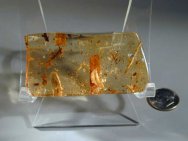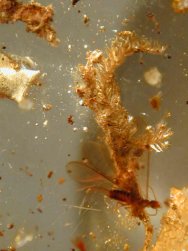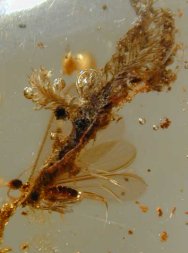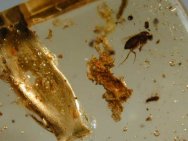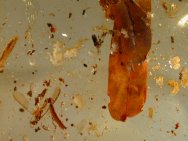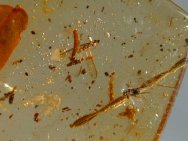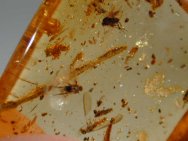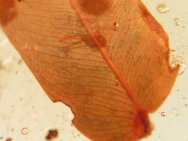|  This
amber may be particularly appealing for those interested in the
Kingdom of life, Plantae, since it contains several representatives
of Embryophyta, or Bryophytes for short, progeny of some of the
oldest plants on Earth. Additionally, it contains 3 beautiful
leaves of 20, 10 and 13 mm length, an ostensible root that is
19 mm long. Perhaps the most stunning floral inclusion is a Bryophite
that measures some 22 mm. Throw in 13 insects, 2 Alates (the winged,
sexual form of termites), a wasp, and the rest Dipterans, and
you have one stunning piece of amber. This amber measuring 63
by 32 mm is itself a plant fossil that has captured much of the
dynamic interaction of life in an ancient rainforest. This
amber may be particularly appealing for those interested in the
Kingdom of life, Plantae, since it contains several representatives
of Embryophyta, or Bryophytes for short, progeny of some of the
oldest plants on Earth. Additionally, it contains 3 beautiful
leaves of 20, 10 and 13 mm length, an ostensible root that is
19 mm long. Perhaps the most stunning floral inclusion is a Bryophite
that measures some 22 mm. Throw in 13 insects, 2 Alates (the winged,
sexual form of termites), a wasp, and the rest Dipterans, and
you have one stunning piece of amber. This amber measuring 63
by 32 mm is itself a plant fossil that has captured much of the
dynamic interaction of life in an ancient rainforest.
Bryophytes
(or, mosses) are embryophyte plants that, despite living on land,
have no vascular to circulate liquids. They neither flower nor
produce seeds, reproducing via spores. They can grow in a wide
range of environments and are poikilohydric: when the environment
dries so does the plant, remaining dormant while dry but recovering
rapidly when wetted.
The
more you look at this specimen with a loupe, the more facinating
it becomes. |

